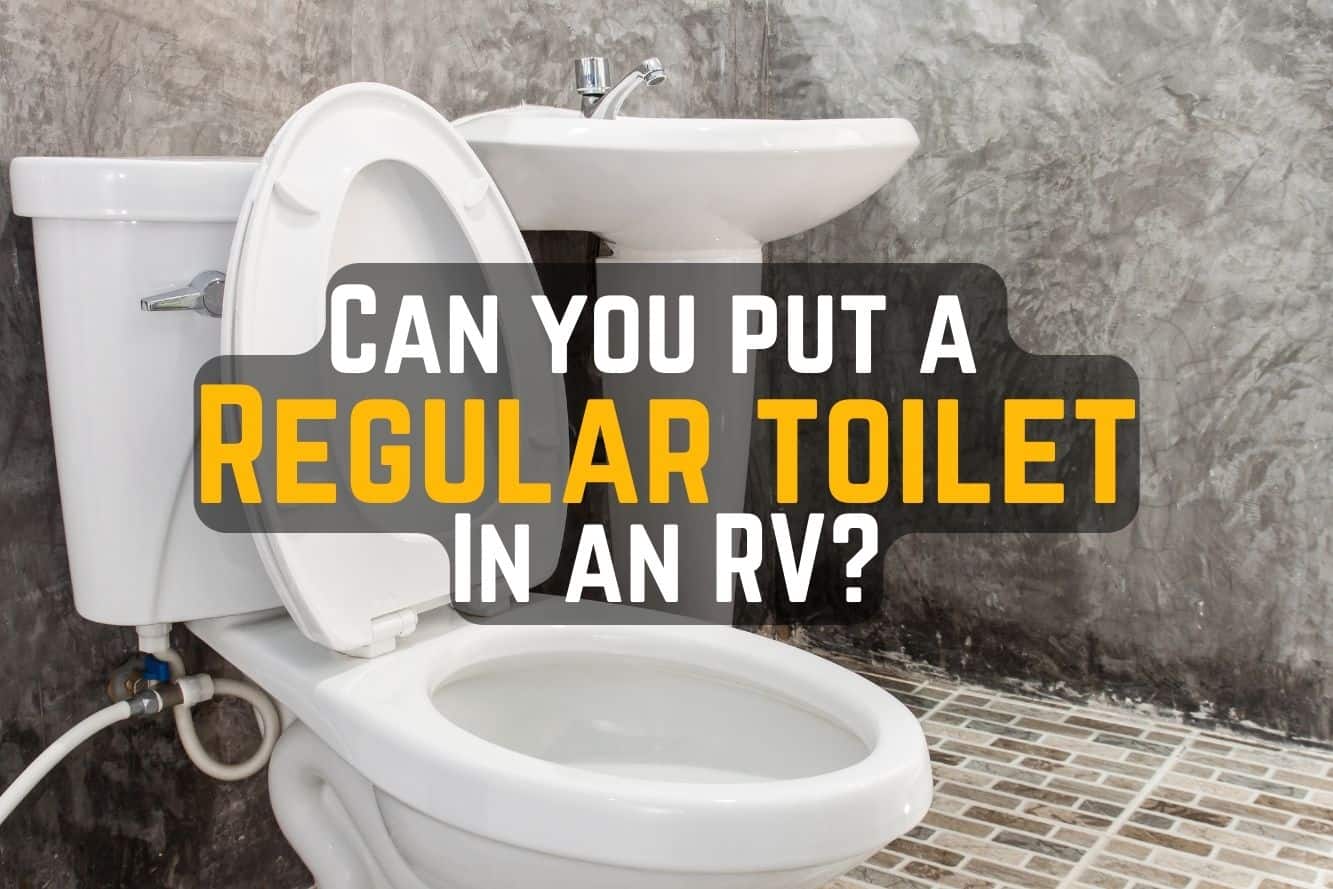If you want a new toilet in your RV, you might be wondering: can you put a regular toilet in an RV? It seems like a no-brainer, right? Swap a toilet for a toilet?
Well, you might be surprised to learn that it’s not quite that simple.
In this in-depth guide, we’re covering why you shouldn’t put a residential toilet in an RV and we provide some alternative options, plus tips to having the most pleasant RV-toilet using experience possible. So, let’s solve the debate once and for all… Can you use a regular toilet in your RV?
Table of Contents
Can You Put a Regular Toilet in an RV?
No, you really shouldn’t put a regular toilet in your RV. While it’s certainly physically possible to put a regular toilet in an RV, it is not recommended for multiple reasons. If you want to replace an RV toilet, choosing a household toilet is an incredibly impractical solution because of the size, material, water consumption, plumbing, and many other factors.
However, we definitely understand why you might want to replace your RV toilet with a home toilet. RV toilets can be difficult to use and uncomfortable, and some of them feel cheap. Oh yeah, they can smell bad and break, too. But RV thrones don’t always have to be a bad experience!
RV Toilet Types
There are many types of RV toilets. Whether you’re just used to the standard, plastic-feeling toilet that comes standard in many newer or older campers or maybe all you’ve had experience with is a cassette toilet, there are several different types you can choose from.
Standard Gravity Toilet
The first type of toilet on the list is the standard gravity flush toilet. These types of RV toilets work pretty much exactly how they sound: they use gravity to move liquid and solid waste into the RV black water tank. RV gravity toilets typically have a pedal for flushing the toilet, a flap at the bottom of the toilet bowl to seal off the black tank, and sometimes have a handhold sprayer nozzle.
Cassette Toilets
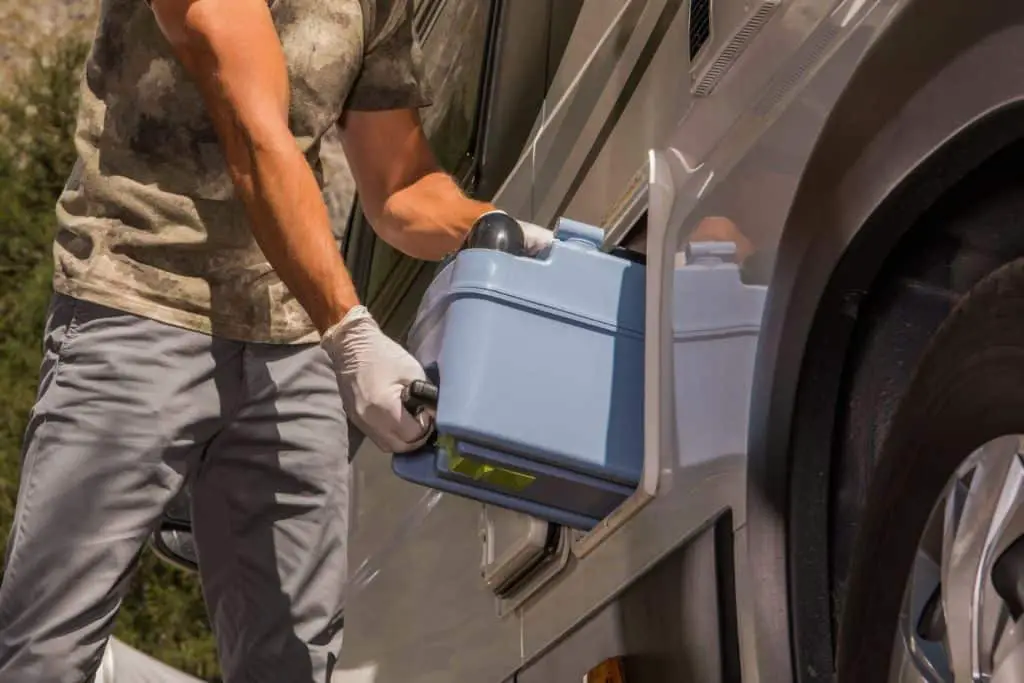
Cassette toilets are a type of all-in-one toilet that is comprised of a toilet bowl, a freshwater tank, and a waste storage tank. These toilets are frequently seen in smaller campers and RVs like travel trailers, pop-up campers, and in many European RVs and camper vans. They’re similar to portable toilets, except these toilets are built-in to the camper or van.
Composting Toilets
Composting toilets are a type of self-contained toilet that doesn’t use water. Instead, these toilets have a separate holding area for liquid and solid waste. The liquid is funneled into a jug of some sort, while the solid waste is deposited into a bin with composting material that helps break it down into a non-offensive organic compost. And we know what you’re thinking but no, these toilets actually don’t smell at all.
Dry Flush Toilets
Dry flush toilets are a type of waterless toilet that function similarly to a diaper genie. They have a waste bag under the bowl of the toilet and a mechanism that seals off part of the bag after each use and twists it tight to prevent odor or liquid leakage. These are a less common type of RV-friendly toilet, but some RVers use them.
7 Reasons Why You Can’t (or Shouldn’t) Put a Residential Toilet in an RV
As we previously mentioned, adding a regular toilet to your RV is an impractical option, especially when there are so many different types of RV toilets you can try. If you want specifics, here are the top reasons you shouldn’t put a house toilet in your RV.
1. RV Toilets Are Made to Withstand the Movement of an RV
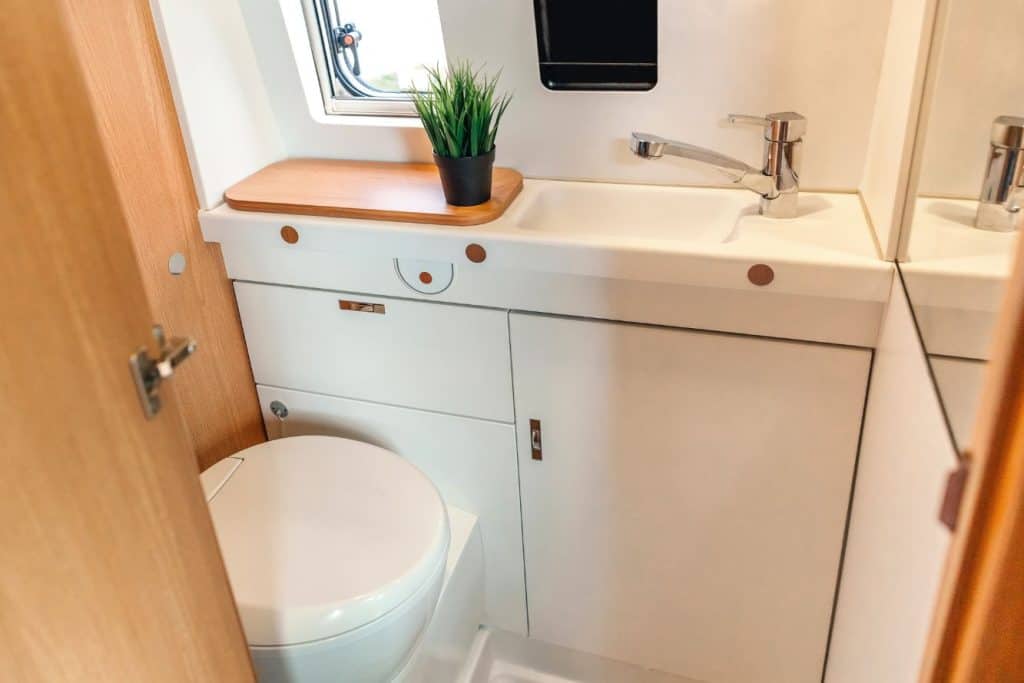
First and foremost, RV toilets are designed to withstand the movement of an RV. They have only a few parts, and their parts are flexible and easy to repair and replace. They don’t hold a tank of water like a standard toilet from a house would, and they’re made of a material that can move and flex with the RV. However, even if you don’t plan to move your RV often (or ever), replacing an RV toilet with a house toilet is an impractical option for the following reasons.
2. Residential Toilet Size and Weight
Household toilets are typically made of porcelain or ceramic and because of this, they are extremely heavy. They’re also a lot larger than RV toilets in both height, width, and depth. Most RV toilets are small and compact because RV bathrooms have limited space.
3. Residential Toilets Use Too Much Water
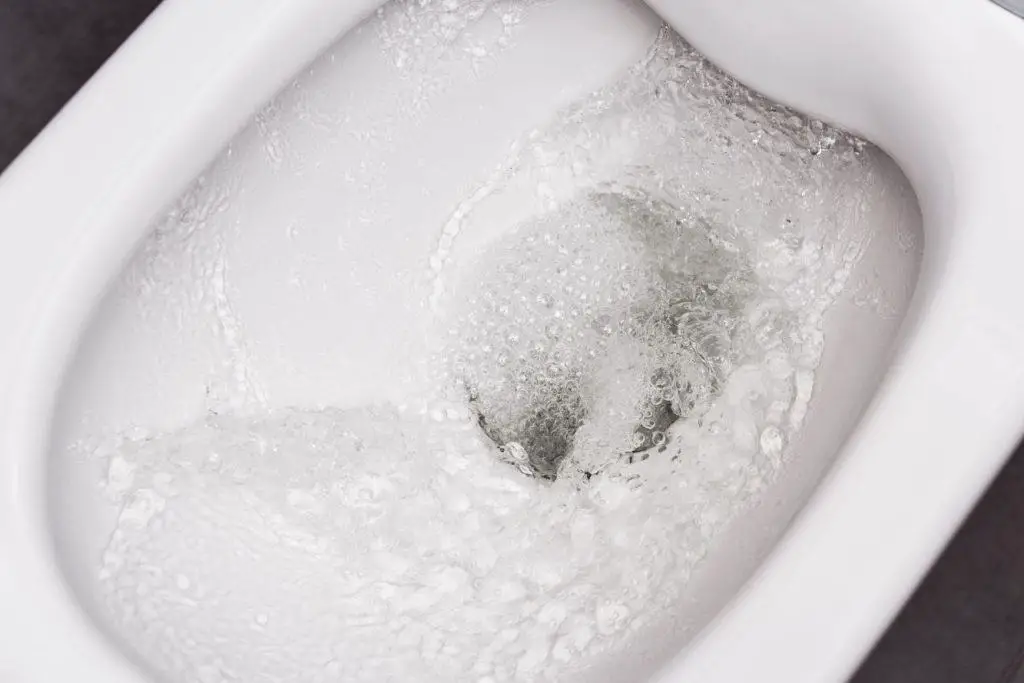
The average household toilet uses around 2.2 gallons of water per flush, according to a Household Water Use Index study of 5.9 million households by a company called Flume. By contrast, RV and camper toilets typically use between 1-4 liters per flush, and the amount of water an RV toilet uses per flush is entirely controlled by the user and how long they hold down the flush pedal.
RV black tanks are typically the smallest waste tank on an RV, and how much they hold varies depending on the size of your camper. Black water tanks can hold anywhere from 10-50 gallons of water. With regular usage of a camper toilet, most RV users only have to empty their black wastewater tank every week or two. But if you used a residential toilet, you could expect to have to dump your black water tank every couple of days.
4. They Can Break
There are many ways a household toilet can break in an RV. They could leak, they could crack, they could shatter, the list goes on and on. These types of toilets just aren’t made for an RV.
5. RV Toilets Have Simple Plumbing
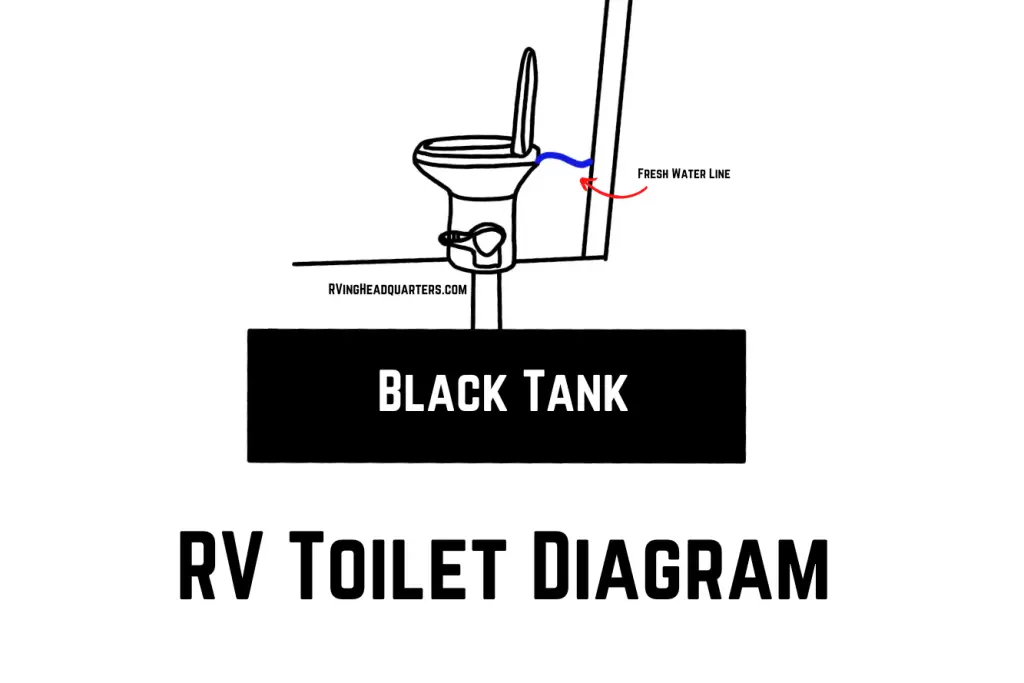
Unlike household thrones, RV toilets have very simple plumbing. They have a small freshwater connection on the back of the bowl that allows the user to flush the toilet, and they sit directly over your RV black tank, connected to a short pipe.
A regular toilet has more complicated plumbing than an RV toilet, requiring water in the tank and the bowl.
6. RV Toilets Flush Differently Than Regular Toilets
RV toilets work differently than the toilet in a house. An RV toilet uses gravity to drop waste directly into the black tank, and the fresh water connection on the toilet helps to clean the bowl and rinse down solid waste and toilet paper.
This is unlike a residential toilet which has a p-trap and a large holding tank full of water that it uses to force waste through the plumbing.
7. Regular Toilets are More Expensive and Impractical
Last but not least, household toilets are heavy, big, expensive, and overall impractical. If you haven’t guessed it by now, replacing your toilet in your RV with a residential toilet would be a bad idea, especially when you have such great alternative options available.
Alternatives to Installing a Regular Toilet in Your RV
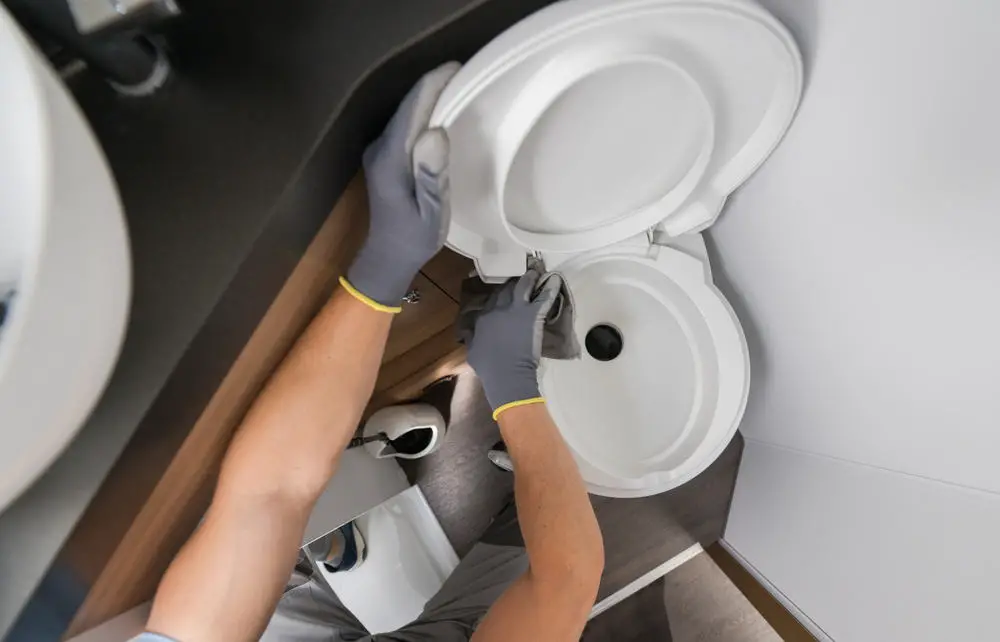
Although you can’t put a regular household toilet in an RV, there are types of RV toilets you can install that have a similar look and feel to a residential toilet.
For example, installing a porcelain or ceramic camper toilet provides a similar look and feel to a regular toilet. They are much easier to clean than the standard toilet that comes in an RV, which is usually made out of a plastic polymer material.
On the other hand, installing a composting toilet is a much different user experience than a household toilet, but it provides many benefits, like using no water, never dealing with raw sewage again, and various other benefits.
No matter what your issue is with your toilet, it can likely be solved by replacing it with another type of RV-friendly toilet. Whether you need a taller toilet, one that’s easier to clean, one that won’t clog your tank like a macerating toilet, or a more eco-friendly option like a composting or dry-flush toilet, there’s something for everyone.
Tips for a Better RV Toilet Experience
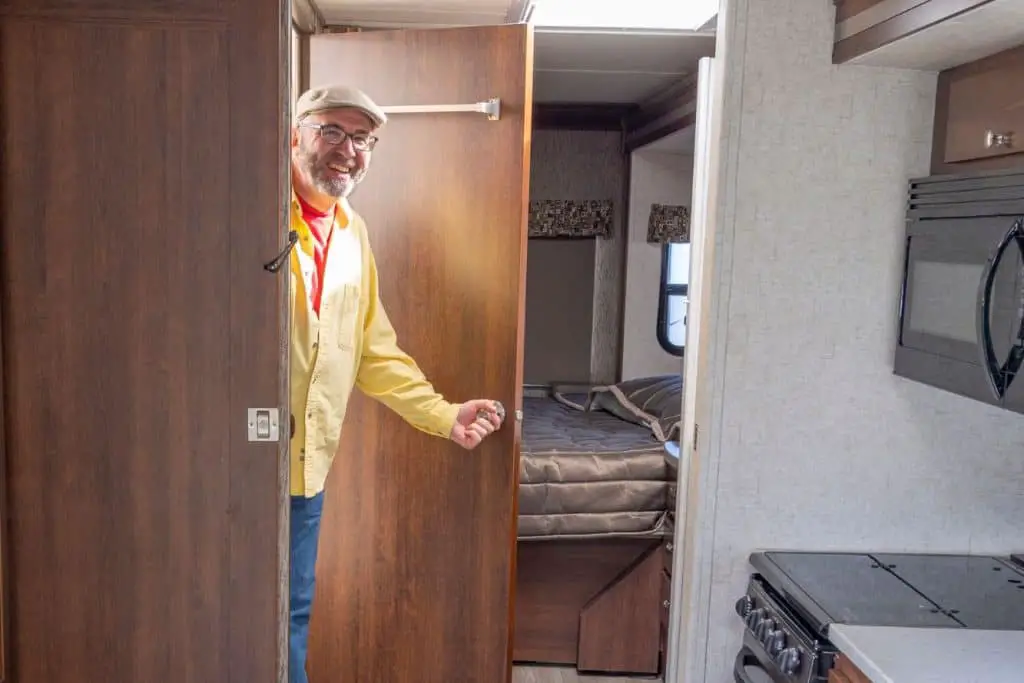
Common RV toilet issues include a smelly toilet, leaking, the toilet seal not holding water, the toilet being difficult to clean, or the toilet just not being comfortable to use like you might be used to from your home toilet. Here are some tips to help you deal with each of these issues.
Sewer Odors: If you’re experiencing unpleasant RV sewer odors, there are a few things to check. The first thing to check is whether or not your RV toilet flap has a proper seal. The flap on your RV toilet is bordered by a rubber flange, and the purpose of this flange is two-fold. It seals your RV off from the odors of the black tank and allows your toilet to hold water. Ensure that the toilet flange has a good seal and keep around 1-2 inches of water in the bowl at all times. If your flange isn’t holding water, you can easily replace it yourself or hire an RV technician to do it for you.
Leaking Toilet: If the toilet in your RV is leaking, the first thing to do is check the freshwater connection. If it’s leaking at the base, it may have a broken gasket, which is pretty easy to replace. If it’s leaking at the water connection, it may have a broken O-ring or a crack in a fitting, and both things are easy to fix yourself.
Annoying RV Toilet Issues:
Difficult to clean: If your toilet is difficult to clean, it may be because it’s made out of plastic or it’s old. If that’s the case, replacing your toilet is a good idea, although not necessary. If you want one that’s really easy to clean, go with a ceramic option.
Not comfortable: If you don’t like the feeling of your toilet seat or the height of your toilet, replace it! You can find a different RV toilet that will be more comfortable without having to resort to trying to install a household toilet in your RV, which is an impractical and close to impossible task.
Don’t Replace Your RV Toilet With a Regular Toilet, Try An Alternative Instead
By now you should be aware of all of the toilet options available to you for your RV. And by now, you should also be aware that you cannot replace an RV toilet with a standard house toilet! You need a toilet that’s specifically designed for RV use. If you’ve got an old toilet in your RV that you totally hate, we recommend browsing the new RV toilets on Amazon to get an idea of what kind are available. And when you’re ready to swap them, learning how to replace an RV toilet isn’t difficult, either. No one should be stuck with a toilet they hate!

